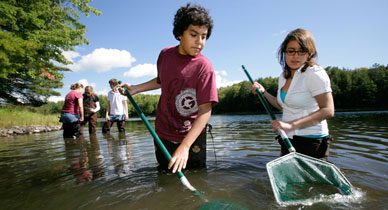

Multimedia
Click here to see a slideshow
of the Conserve School
Related Stories
Links
Growing Green Kids
A Wisconsin school cultivates environmental leaders
With her Mohawk-molded hair, fur-trimmed black sweatshirt and concentrated pout, Hannah does not look “boarding school.” Slouched against the gym bleachers at Wisconsin’s 1,200-acre Conserve School in the Northwoods, she looks more rebel than conformist.
And indeed, her choice to fish the Conserve School brochure out of the trash after her parents casually tossed it may have been her own rebellion. Yet, her involvement among her nearly 150 student peers paints a portrait of fitting in, rather than refusing to conform.
She smiles warmly in describing cross-country running and skiing. She highlights her activities as a community council member. She speaks of attending faithfully to more than five hours of homework each night. Through her descriptions, Hannah crystallizes Conserve’s lifeblood: atypical students embracing an atypical atmosphere where the environment and outdoors coalesce into experiential learning.
Students like Hannah from around the world make the decision to come to the Conserve School because they, or their parents, want the atypical high school experience provided there. With challenging academics, hands-on learning and an unavoidable emphasis on the environment, students sacrifice what the average person thinks of as a normal adolescence for another distinct set of challenges.
This is exactly the experience founder James Lowenstine hoped the school would offer to students. Although the institution itself has only been around for six years, Lowenstine had been hatching and developing his plan to share the importance of nature for nearly four decades, long before any of the current students were even born.
Approaching the main academic building, appropriately named for its founder and donned with a bronze plaque, Lowenstine’s golden face peers out from above a short poem he wrote in 1965 for his future protégés:
“To the future young folks of Lowenwood: I wish you all love, hope, happiness, and a long and healthful life. May your understanding of mankind be broadened through your association with and, I am sure, your love of Lowenwood.”
Although the headmaster, Stefan Anderson, never met Lowenstine personally, he has meticulously read through his journals to ensure he was consistent with the school’s initial intention.
“He changed the name to Conserve School, because he didn’t want the mission to get lost over time,” Anderson says. “It embedded the mission of the school in the name of the school.”
Anderson also notes that Lowenstine did not get too specific about the school. He understood that with changing technology, the people in charge of realizing his dream would have to make judgments he could not foresee, yet always putting an emphasis on the importance of conserving the environment.
For example, the school did not have a public sewage treatment plant, so the trustees decided to purchase the more expensive but less harmful Green Machine that uses all natural processes, turning waste into fertilizer and not releasing harmful chemicals into the environment.
Certain environmentally friendly features of the school, however, were not built at the beginning, but were put in gradually so students could be part of the entire process from writing the grant applications to obtaining permits.
“We could have built the school with solar panels and windmills,” Anderson says. “Instead of doing that, we decided to wait and put those in when the kids were here on campus so the kids were involved with the whole process from start to finish.”
Like these projects, much of the learning done at the Conserve School is learning by doing and tries to incorporate real-world problems. The students are encouraged to do independent projects. According to Anderson, more than half of the seniors graduate with at least one research project, and the school once purchased a seismograph to help a student complete his project after expressing interest in earthquakes.
This emphasis on hands-on learning can be seen in the classrooms as well. Upon wandering into a wildlife biology classroom, it is striking to see the students sitting on the desks casually in a small circle, each holding a leaf as the teacher explains the possibility of identifying different arboreal species.
Home I Mind I Body I Soul I Site Map
About Us I Contact Us I Business Partners I Archives
Copyright 2008 Curb Magazine